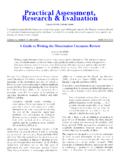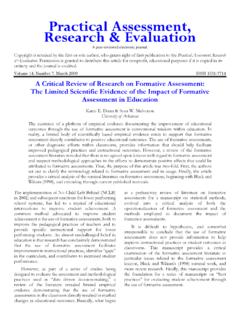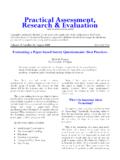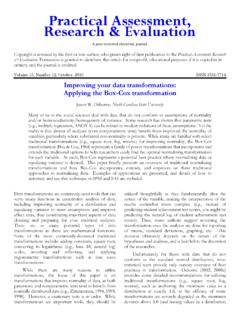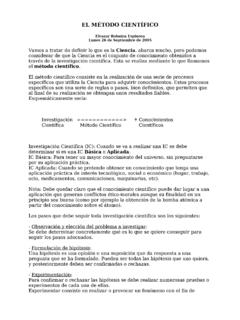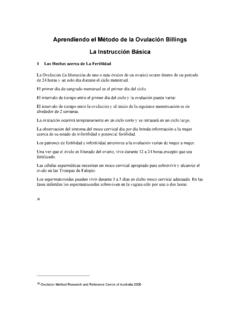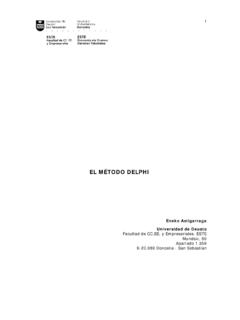Transcription of A peer-reviewed electronic journal.
1 A peer-reviewed electronic journal. Copyright is retained by the first or sole author, who grants right of first publication to the Practical Assessment, Research & Evaluation. Permission is granted to distribute this article for nonprofit, educational purposes if it is copied in its entirety and the journal is 12, Number 10, August 2007 ISSN 1531-7714 The Delphi Technique: Making Sense Of Consensus Chia-Chien Hsu, The Ohio State University & Brian A. Sandford, Oklahoma State University The Delphi technique is a widely used and accepted method for gathering data from respondents within their domain of expertise. The technique is designed as a group communication process which aims to achieve a convergence of opinion on a specific real-world issue.
2 The Delphi process has been used in various fields of study such as program planning, needs assessment, policy determination, and resource utilization to develop a full range of alternatives, explore or expose underlying assumptions, as well as correlate judgments on a topic spanning a wide range of disciplines. The Delphi technique is well suited as a method for consensus-building by using a series of questionnaires delivered using multiple iterations to collect data from a panel of selected subjects. Subject selection, time frames for conducting and completing a study, the possibility of low response rates, and unintentionally guiding feedback from the respondent group are areas which should be considered when designing and implementing a Delphi study.
3 The Delphi technique, mainly developed by Dalkey and Helmer (1963) at the Rand Corporation in the 1950s, is a widely used and accepted method for achieving convergence of opinion concerning real-world knowledge solicited from experts within certain topic areas. Predicated on the rationale that, two heads are better than one, heads are better than one (Dalkey, 1972, p. 15), the Delphi technique is designed as a group communication process that aims at conducting detailed examinations and discussions of a specific issue for the purpose of goal setting, policy investigation, or predicting the occurrence of future events (Ulschak, 1983; Turoff & Hiltz, 1996; Ludwig, 1997).
4 Common surveys try to identify what is, whereas the Delphi technique attempts to address what could/should be (Miller, 2006). In the literature, Delphi has been applied in various fields such as program planning, needs assessment, policy determination, and resource utilization. Delbecq, Van de Ven, and Gustafson (1975) specifically indicate that the Delphi technique can be used for achieving the following objectives: 1. To determine or develop a range of possible program alternatives; 2. To explore or expose underlying assumptions or information leading to different judgments; 3. To seek out information which may generate a consensus on the part of the respondent group; 4. To correlate informed judgments on a topic spanning a wide range of disciplines, and; 5.
5 To educate the respondent group as to the diverse and interrelated aspects of the topic (p. 11). CHARACTERISTICS OF THE DELPHI TECHNIQUE The Delphi technique is well suited as a means and method for consensus-building by using a series of questionnaires to collect data from a panel of selected subjects (Dalkey & Helmer, 1963; Dalkey, 1969; Linstone & Turoff, 1975; Lindeman, 1981; Martino, 1983; Young & Jamieson, 2001). Delphi, in contrast to other data gathering and analysis techniques, employs multiple iterations designed to Practical Assessment, Research & Evaluation, Vol 12, No 10 2 Hsu & Sandford, Delphi Technique develop a consensus of opinion concerning a specific topic.
6 Ludwig (1994) indicates: Iterations refer to the feedback process. The process was viewed as a series of rounds; in each round every participant worked through a questionnaire which was returned to the researcher who collected, edited, and returned to every participant a statement of the position of the whole group and the participant s own position. A summation of comments made each participant aware of the range of opinions and the reasons underlying those opinions (p. 55). More specifically, the feedback process allows and encourages the selected Delphi participants to reassess their initial judgments about the information provided in previous iterations. Thus, in a Delphi study, the results of previous iterations regarding specific statements and/or items can change or be modified by individual panel members in later iterations based on their ability to review and assess the comments and feedback provided by the other Delphi panelists.
7 Other notable characteristics inherent with using the Delphi technique are the ability to provide anonymity to respondents, a controlled feedback process, and the suitability of a variety of statistical analysis techniques to interpret the data (Dalkey, 1972; Ludlow, 1975; Douglas, 1983). These characteristics are designed to offset the shortcomings of conventional means of pooling opinions obtained from a group interaction ( , influences of dominant individuals, noise, and group pressure for conformity) (Dalkey, 1972). One of the primary characteristics and advantages of the Delphi process is subject anonymity which can reduce the effects of dominant individuals which often is a concern when using group-based processes used to collect and synthesize information (Dalkey, 1972).
8 Additionally, the issue of confidentiality is facilitated by geographic dispersion of the subjects as well as the use of electronic communication such as e-mail to solicit and exchange information. As such, certain downsides associated with group dynamics such as manipulation or coercion to conform or adopt a certain viewpoint can be minimized (Helmer & Rescher, 1959; Oh, 1974; Adams, 2001). Controlled feedback in the Delphi process is designed to reduce the effect of noise. Based upon Dalkey (1972), noise is that communication which occurs in a group process which both distorts the data and deals with group and/or individual interests rather than focusing on problem solving.
9 As a result, the information developed from this kind of communication generally consists of bias not related to the purposes of the study. Basically, the controlled feedback process consists of a well organized summary of the prior iteration intentionally distributed to the subjects which allows each participant an opportunity to generate additional insights and more thoroughly clarify the information developed by previous iterations. Through the operation of multiple iterations, subjects are expected to become more problem-solving oriented, to offer their opinions more insightfully, and to minimize the effects of noise. Finally, the ability to use statistical analysis techniques is a practice which further reduces the potential of group pressure for conformity (Dalkey, 1972).
10 More specifically, statistical analysis can ensure that opinions generated by each subject of a Delphi study are well represented in the final iteration because, at the end of the exercise there may still be a significant spread in individual opinions (Dalkey, 1972, p. 21). That is, each subject would have no pressure, either real or perceived, to conform to another participant s responses that may originate from obedience to social norms, customs, organizational culture, or standing within a profession. The tools of statistical analysis allow for an objective and impartial analysis and summarization of the collected data. THE DELPHI PROCESS Theoretically, the Delphi process can be continuously iterated until consensus is determined to have been achieved.

